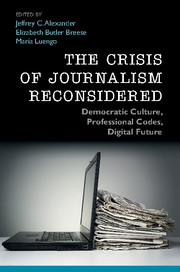Book contents
- Frontmatter
- Dedication
- Contents
- About the Contributors
- Preface
- Acknowledgments
- Introduction: Journalism, democratic culture, and creative reconstruction
- PART I THE CRISIS NARRATIVE
- PART II FEARS OF DIGITAL NEWS MEDIA: THE SYMBOLIC STRUGGLE
- 6 When codes collide: Journalists push back against digital desecration
- 7 Telling the crisis story of journalism: Narratives of normative reassurance in Page One
- 8 Assembling publics, assembling routines, assembling values: Journalistic self-conception and the crisis in journalism
- 9 The constancy of immediacy: From printing press to digital age
- 10 News on new platforms: Norwegian journalists face the digital age
- PART III PROFESSIONAL JOURNALISM, CIVIL CODES, AND DIGITAL CULTURE
- Conclusion: News innovations and enduring commitments
- Index
- References
7 - Telling the crisis story of journalism: Narratives of normative reassurance in Page One
from PART II - FEARS OF DIGITAL NEWS MEDIA: THE SYMBOLIC STRUGGLE
Published online by Cambridge University Press: 05 June 2016
- Frontmatter
- Dedication
- Contents
- About the Contributors
- Preface
- Acknowledgments
- Introduction: Journalism, democratic culture, and creative reconstruction
- PART I THE CRISIS NARRATIVE
- PART II FEARS OF DIGITAL NEWS MEDIA: THE SYMBOLIC STRUGGLE
- 6 When codes collide: Journalists push back against digital desecration
- 7 Telling the crisis story of journalism: Narratives of normative reassurance in Page One
- 8 Assembling publics, assembling routines, assembling values: Journalistic self-conception and the crisis in journalism
- 9 The constancy of immediacy: From printing press to digital age
- 10 News on new platforms: Norwegian journalists face the digital age
- PART III PROFESSIONAL JOURNALISM, CIVIL CODES, AND DIGITAL CULTURE
- Conclusion: News innovations and enduring commitments
- Index
- References
Summary
The title gracing the front of this book bears the now familiar phrase “crisis of journalism” to describe the state of traditional journalism in much of the world (Gitlin 2011). While both operative nouns – “journalism” and “crisis” – often appear in close proximity in assessments of the news industry, they share a high degree of definitional ambiguity requiring immediate untangling. Journalism, having never attained the closed ranks of a profession, varies in time and place. What may be considered journalism depends on, among other factors, means of communication, levels of literacy, the norms of the political culture, the judgment of the advertising industry, and the tastes of audiences. And while the intense focus on the present crisis tends to obscure the past in its concern for the future, an examination of journalism's history reveals layers of transformation (Schudson 1982; Stephens 1989). Without the benefit of hindsight, what remains less well understood is how definitions of journalism are changing around us.
It is against this backdrop that we attend to the second concept, crisis. In moving beyond trait-based definitions of what may objectively constitute crisis, this chapter instead stresses crisis as perceptional (Billings, Milburn, and Schaalman 1980; Boin 2004). From this viewpoint, a crisis entails “events or developments widely perceived by members of relevant communities to constitute urgent threats to core community values and structures” (Boin, ‘T Hart, and McConnell 2009). While deeply constructionist, this view does not deny events exist outside of being perceived as crisis-making. After all, newspaper stock prices plummeted in 2008 irrespective of how such declines for journalism were interpreted. Instead, crisis is a “process” that requires “both a subject and an object” (Hay 1996, 254). What matters analytically is how events are made meaningful, with certain spokespersons speaking from particular positions with particular motives casting events as a crisis. Nor does this perspective automatically cast suspicion on those who publicly cry “crisis.” Social actors fearing disruption of their “core community values and structures” do so earnestly.
Viewing crisis as an interpretive frame social actors apply to a set of events or conditions (Hay 1996) attunes us to “framing contests” where basic issues of causality support a whole array of responses (Boin, ‘T Hart and McConnell 2009). Such contests rely on symbols of the crisis and how it should be managed (‘T Hart 1993).
- Type
- Chapter
- Information
- The Crisis of Journalism ReconsideredDemocratic Culture, Professional Codes, Digital Future, pp. 135 - 152Publisher: Cambridge University PressPrint publication year: 2016
References
- 4
- Cited by

